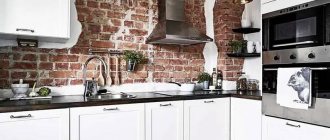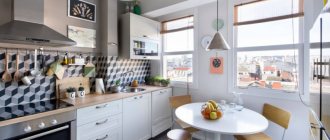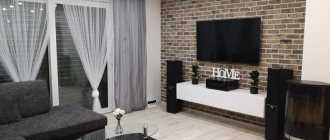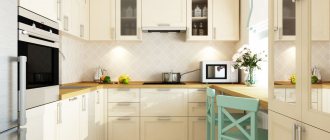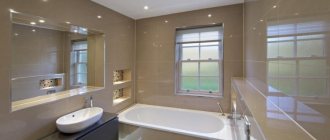A brick wall in the kitchen is a trend that never wants to leave the covers of fashion design magazines. Many are accustomed to associating it with a brutal loft, but such an element can also decorate romantic or gothic styles.
A brick kitchen will appeal to people who are creative, creative and simply open to unusual ideas.
Many people are attracted to this design because it can be created with their own hands quickly and inexpensively, without any experience.
Detailed instructions on how to correctly make the most budget-friendly imitation option:
Advantages and disadvantages
Artificial panels for the kitchen and natural brick have their pros and cons in interior design.
| Pros of a brick kitchen | Flaws |
| 1. Brickwork is always a bright accent in a room. 2. Natural materials do not require prompt repairs. 3. Brick can be used even in open spaces - in a summer kitchen. 4. You can do the repairs yourself on a modest budget. | 1. The surface of the material must be resistant to moisture and temperature changes. 2. Dirt may accumulate between the bricks, making it difficult to clean. 3. Takes up a lot of space if you use natural masonry or volumetric imitation. |
Tip 5. Take care of additional processing
If you want to place a brick directly next to the oven or use it to decorate an apron, we recommend that you additionally cover it with a thin layer of scraping varnish. This will greatly simplify cleaning - dirt and grease will not penetrate the pores of the material, which means the coating will last you longer.
If you want to use brick near the work surface, it is better to further process it
If you are afraid that such processing will spoil the texture of the brick, do not worry. Modern materials can be applied in one layer, so that they form a thin protective film, not too noticeable at first glance.
Modern means make processing invisible
In addition, no one forces you to choose a flashy glossy finish - you can easily use matte varnish.
How to replace natural material
Decorative brick does not have to be natural. You can make brick-like tiles from porcelain stoneware, PVC, MDF, clinker, gypsum, and plastic. The interior of a kitchen made with imitation material looks no worse than when using natural masonry.
General design rules
The design of a kitchen that features brickwork is based on a number of factors. They should be taken into account before wall decoration begins.
Color solution
The interior design of the room is demanding on the color scheme. In the kitchen it is also important to have a lighted work area. Therefore, when choosing a dark shade for brickwork in this room, it is worth considering whether there will be shades of light in the room and whether there is a sufficient level of illumination.
Light wall
White brickwork in the kitchen apron area or the entire wall, near the dining table, will help make a small room brighter. For covering surfaces in small rooms, it is better to use photo wallpaper and exclusively light shades of brick to visually increase the area of the room.
Dark colors
To repair a wall in dark colors, it is better to use ready-made brick panels: there is always a lot of dirt in the kitchen, and the smooth surface of such material is easy to clean. If the room is large but dark, it is better to focus on 1-2 dark brick elements - for example, in the area for the apron and behind the refrigerator.
Option for children's
A controversial solution is brick finishing in the room where the children are located. The rough appearance looks somewhat harsh for the tender age of babies. But for older children, whose imagination is already so developed that they prefer the style of castles or living conditions in catacombs, such a discovery will be interesting.
The coating is both safe and pleasant to the touch.
The informal thinking of the younger generation makes such unusual decoration especially attractive. This unique canvas will take on posters, paintings with abstractions and all kinds of photographs of idols.
In what design styles is a brick wall suitable for the kitchen?
Brick kitchen decoration is appropriate for many interior styles. The main thing is to take into account the design features and not overload it with an abundance of decor.
Loft
A loft-style kitchen probably simply must include brickwork. It gives naturalness, conciseness and asceticism. Usually natural types of brick or its high-quality imitation of natural shades are used - red, brown, with a rough surface.
Scandinavian
This is a light style, with the addition of simple contrasting elements. Brickwork in a Scandinavian-style kitchen should be a white, cool shade. It can be diluted with wooden decor and furniture.
Country
For country style, decorative bricks are used to decorate the entire wall behind the kitchen furniture or the area above the apron. It is better to use light colors, diluting them with bright ethnic decor and dishes made from natural materials.
Provence
In Provence there is also a place for kitchen bricks. But you shouldn’t highlight large areas and use dark shades. Milky, olive tones and a rough surface with a natural effect will be more appropriate than bright white gloss.
Pop Art
In a house with a kitchen, pop art brick will emphasize creativity and creative impulses. Combinations of different textures, shades, contrast with bright pictures, plastic decor on the set and wooden furniture are appropriate here.
Wallpaper
If you doubt whether this interior solution will suit you, you can “rehearse” it by gluing wallpaper with a brick pattern.
Now manufacturers offer a huge selection of such wallpapers:
- From a simple schematic image to a three-dimensional and textured one, when from a distance you won’t understand that this is wallpaper in front of you.
- Perfect as a decorative option in the eating area or where storage is organized.
- The main thing is to avoid contact with water and fire!
Tile
There is a huge selection of tiles that imitate masonry. These can be luxurious cuts of natural vintage brick, or budget gypsum tiles. It will turn out quite natural and relief. This option is suitable for both decoration and practical purposes, because the materials are washable, heat- and wear-resistant.
Gypsum plaster
An excellent and very budget solution is to create a brick wall with your own hands using gypsum plaster. A master can help you with this, but if you decide to do it yourself, you will get a lot of positive emotions and valuable experience. We'll tell you further how to make a wall from such plaster with your own hands!
Finally, if you like the graphic effect that brick creates on a wall, but don't want to use any of the materials listed, tile may be your option.
A very common model now is the “white boar” - an elongated tile in the shape of a rectangle. It will appeal to those who want to decorate an apron.
How to choose brick tiles
When you don’t have time to lay natural tiles, you can choose imitation. Things to consider:
- Room area, dimensions.
- Room style.
- Features of the climate.
- Your wishes.
- Budget.
A ready-made ceramic brick kitchen apron will cost more than a plastic panel. But a high price is not always an indicator that this kitchen material will be better than a more affordable one.
Types of bricks
Brick in kitchen design can be different. Natural coverage works best, but it is not always appropriate. It is not necessary to buy natural material if there is no money or space does not allow. It can be replaced with an imitation, and done with your own hands.
Natural brick
A brick summer kitchen should be made primarily from natural materials. For example, natural masonry. It is massive, durable and is not afraid of temperature changes and humidity. But the cost of natural bricks, especially unusual shades, is higher than artificial materials.
Facing brick
It is made from several materials: clinker, ceramics, gypsum, porcelain stoneware. Outwardly it is very similar to natural, but inferior to it in strength. Easy to install.
Tip 3. Decide on the texture
The brick does not have to be porous, like the one we are used to seeing in exterior decoration. Now the blocks are treated with a special glaze, which allows you to give the most varied appearance to the material.
Bricks can be very different
For example, you can use classic matte bricks - they are great for creating traditional interiors.
The usual matte brick
However, glossy glazed bricks also look very interesting. In addition, due to their reflective properties, they visually make a small kitchen larger. A significant bonus, especially when you consider that the brick itself conceals the space, making it smaller and cramped.
Interesting and attractive solution
A fashionable solution for interiors in the industrial loft style is chipped brick. The blocks appear a little broken, their edges are torn, and their texture is uneven. Due to this, the coating seems very voluminous and original. True, you need to work with such material very carefully, otherwise the kitchen will take on a sloppy, abandoned appearance.
Rough finishes should be compensated with elegant furniture
Brickwork in kitchen design
For the kitchen, brick is a fairly popular material. Natural is suitable for the apron area, and lightweight plastic, panels or gypsum are suitable for wall cladding. When choosing, you should consider the style of the room’s design and its dimensions.
Loft
Brick tiles for a loft kitchen are always a suitable solution. You can cover a large space with it, including several walls and an apron area, and experiment with shades.
Country
Another style in the spirit of romanticism and rustic motifs, in which brickwork can be done exclusively in natural shades. Unlike romanticism, dark brick may be appropriate here, but only in natural tones. It is better to choose open areas: an apron, a wall, including a natural structure, which can be simply treated and left unchanged.
Provence
A kitchen in the Provence style is characterized by the use of romantic, “rustic” decor. Brick will fit into such an interior if it is light in color and has a glossy texture. It can be set off with decor made of wood (table, set), furniture made of soft fabrics (sofa, chairs), paintings with light frames. Colors for masonry - white, milky, blue, beige, lilac.
Minimalism
Does not provide a lot of decor and an abundance of bright colors. Therefore, brickwork can become the only bright accent in the kitchen. You can highlight an apron or an entire wall. The main thing is not to load the surface with other details and adhere to the unity of textures.
Antique style
Combines different textures from natural wood, stone, metal. Therefore, it is better to choose large surfaces for brick in the kitchen and natural shades - brown, red, burgundy.
English style
The conservative English style does not accept aggressive decisions. Therefore, the color of the brick in the kitchen should be light, and the masonry itself should be small and harmonious, for example, in the apron area.
In harmony with nature: how to take into account the cardinal directions when choosing colors
When choosing colors, shades and patterns for wallpaper, be sure to take into account the orientation of the room relative to the cardinal directions.
For rooms facing north, choose warm and bright colors (red, yellow, orange), which will help reduce the feeling of coldness, drowsiness and fatigue, especially in the winter-autumn period.
Orange wallpaper in the kitchen space or an orange kitchen always looks lively, original, dynamic and fresh.
Rooms with windows facing south are decorated in cool colors: blue, purple, gray, blue. Neutral tones will be appropriate for the western and eastern sides.
For the kitchen, wallpapers most often chosen are cream shades, brown-beige, and bluish-green. Rooms with poor lighting are painted in light yellow and light pink tones, which increase the reflection of light, thereby increasing the degree of illumination in the room.
Color palette
Brickwork in the kitchen is distinguished by a variety of colors. Each shade is appropriate in a specific style and is selected in accordance with a specific room and interior design.
White brick in the kitchen interior
White brick is common in the kitchen. It visually makes the space lighter, the room wider, more spacious. You can lay the entire wall or just the apron area - it all depends on the size of the room and the choice of material.
Red brick
Red brick masonry in a kitchen is usually placed above the countertop. If the house is brick, you can leave one small wall, cleaning it and covering it with protective varnish.
Gray brick
Design solutions with gray brick are often embodied in loft kitchens. Other colors used for interior decoration when choosing cladding of this shade: white, black, dark brown, silver.
Black brick
Wall cladding with black brick is appropriate only in moderation - in the apron area, behind the kitchen unit, behind the TV, refrigerator and other appliances. This option is only suitable for a room with natural light and large windows: the black color and rough surface of the brickwork will “take away” the light. Therefore, darkened kitchens with black brickwork will be quite gloomy.
Aged brick
A kitchen-living room with natural aged brick in a classic, modern or loft style will look most advantageous. This option is appropriate when the house/apartment has a finished brick wall, for example, the load-bearing structure of a building. Repair costs here will be minimal, and the surface itself will become one of the main accents of the interior.
Features of decorative brick finishing
When choosing a finish, you need to pay attention to the following nuances:
- Brick is a porous material, and therefore needs to be treated with water-repellent impregnations so that the masonry does not lose its attractiveness.
- The cladding, even with the thinnest brick, will hide useful centimeters. If the kitchen is small, it is better to lay out the dining or work area with bricks, and make all other surfaces plain. An excellent solution would be white masonry.
- Since this finish does not have very good reflective properties, it is advisable to decorate the wall located opposite the window with brick. Thus, natural light will smooth out such a disadvantage.
- In addition, the accent wall in the kitchen should be properly lit. In order to emphasize the beauty of the finish, several lamps are installed.
- Any brick finish will fit into the interior of a spacious kitchen space. Gray, black or dark red masonry will not affect the volume of a large room.
- For a kitchen in an apartment located in an old house, the simplest finishing option would be a natural brick wall. To give the surface a presentable appearance and protect it from dust and dirt, it should be coated with paint or varnish.
Great examples and ideas for a brick kitchen
Ideas for using bricks in the kitchen:
- Apron.
- Dinner Zone.
- The area near the window opening.
- The area behind the kitchen unit.
- One wall.
- All walls in the room.
- False wall.
- Area behind appliances (TV, refrigerator, microwave oven).
Brick has been used in the kitchen for a long time. To make it last longer, the finished surface should be treated with a protective layer from moisture and dust.
Read
